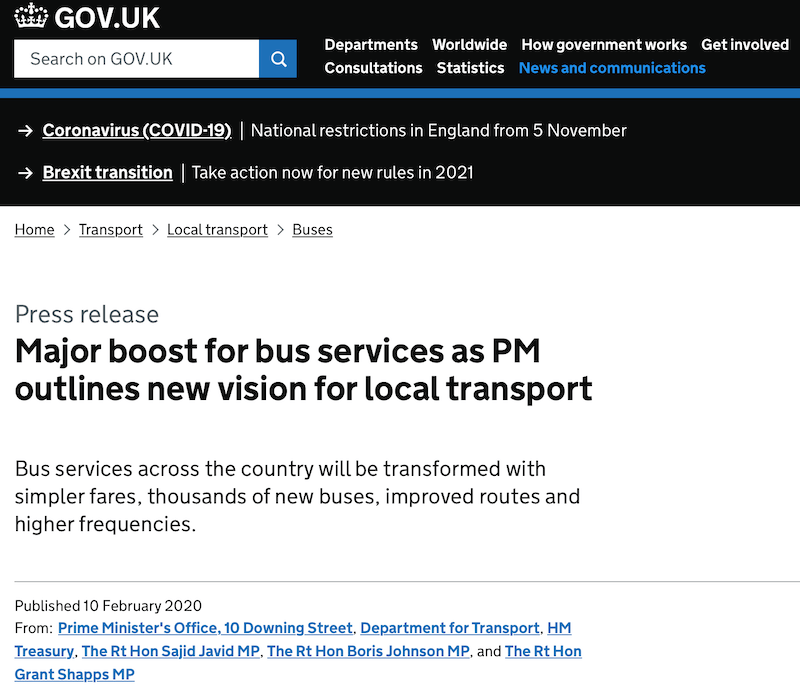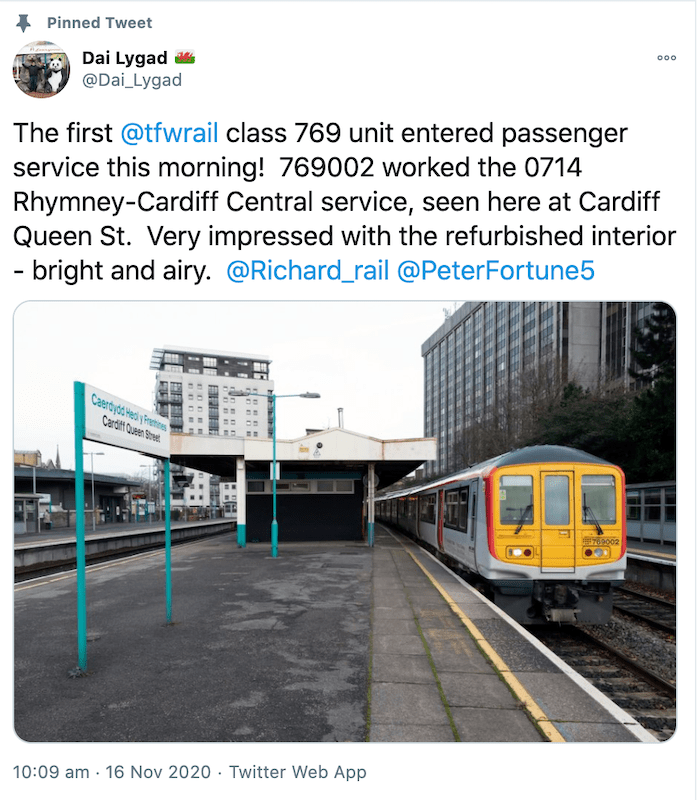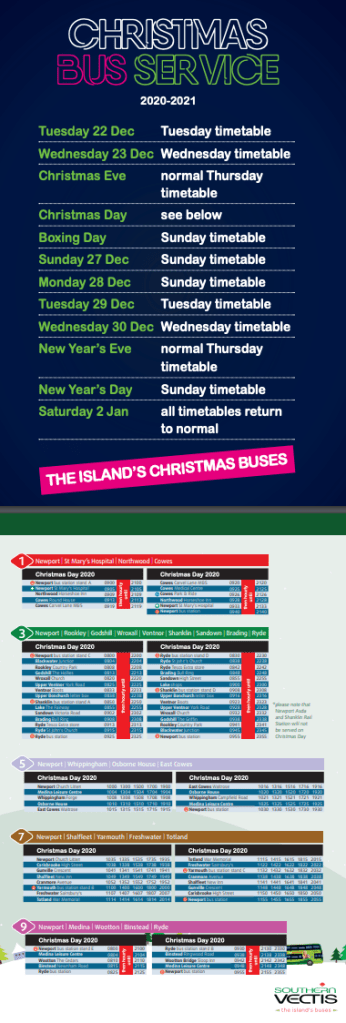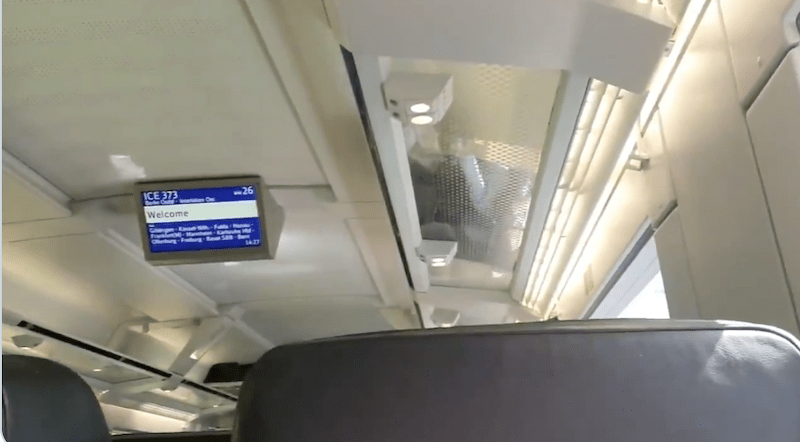Saturday 21st November 2020

One big upside of this week’s so called Government ‘reset’ after Dom’s Downing Street departure was Monday’s welcome return of the Morgan-v-Hancock…Jenrick…Sharma…(et al) head-to-head on ITV’s Good Morning Britain. No-one does a Cabinet grilling quite like Piers Morgan and it’s proving a ratings beating TV fest, but all the while the Minister woefully waffles and obfuscates the questions doing a ‘live to camera’ outside the Beeb in Langham Place I can’t help spotting TfL’s finest pass by in the background. You really appreciate just how frequent routes 88 and 453 are and just how few passengers are travelling.

Another reset upside was Wednesday’s welcome Government announcement of its “Ten Point Plan for a Green Industrial Revolution” and in particular point 5, and I quote: “Public transport, cycling and walking: Making cycling and walking more attractive ways to travel and investing in zero-emission public transport of the future.” This wouldn’t by any chance be the same “cycling and walking more attractive ways to travel and investing in zero-emission public transport of the future” announced by Grant Shapps on 9th May….?

…which in turn was part of the £5 billion funding for cycling (£2 million) and buses (£3 million) announced in February …?

That announcement promised: “bus services across the country will be transformed with simpler fares, thousands of new buses, improved routes and higher frequencies”. And if you have any doubts, don’t worry, there’ll be another announcement saying the same thing along in another few months.
Back in those carefree pre-lockdown February days we were all impressed with the £5 billion commitment, but in today’s magic money tree currency £3 billion for buses is the equivalent of just a few months funding for our railways or a couple of Stonehenge tunnels – the latter being part of the promised £27 billion road building programme announced earlier this year in one of Rishi’s many budgets over the last 12 months and which, not surprisingly, didn’t seem to feature in the ten point “Green Industrial Revolution” plan.

By Wednesday the media had left Stonehenge behind and were going full pelt on a vague notion of road pricing following ‘voter sounding out leaks’ to friendly newspapers over the weekend – a subject beloved of local radio phone-ins and always guaranteed to get the rage of motorists heightened to outrage levels about all the “road tax” they already pay.

However this time phone-in hosts were astute enough to tell the petrolhead die-hards this week’s Government commitment new petrol and diesel powered cars and vans will be banned from 2030 inevitably must herald a replacement tax of some kind. Interestingly most motorists were unable to come up with any constructive alternatives other than a designed in objection to road pricing.

Also on Wednesday another Transport Select Committee session looking at how the pandemic has impacted public transport took place. This one was devoted to railways and spent over an hour discussing matters with leading lights from Abellio (Dominic Booth), First Group (Steve Montgomery) and Go-Ahead (Katy Taylor) followed by another hour or so with the Minister, Chris Heaton-Harris, as well as Peter Wilkinson and Neil Hart, both big cheeses at the DfT.
Committee chairman, Huw Merriman, brought in fellow chair of the Public Accounts Committee, the formidable Meg Hillier to quiz the witnesses in her no-messing style on how the £800 million a month life support payments to the railways was giving value for money to taxpayers, along with probing questions from genial committee member Chris Loder (MP for West Dorset, and more pertinently, a former employee of South West Trains) who knows what he’s talking about.

The session began with Dominic Booth, Steve Montgomery and Katy Taylor seting out the stall from Train Operating Companies perspective and not surprisingly they spoke positively of the private companies’ achievements …. overseeing significant growth of passenger journeys leading up to Covid as well as demonstrating agility and flexibility in the period since and full of ideas about delivering better services to win back passengers in the future. As you can imagine most of the Bingo card train-speak buzzwords were soon ticked off with much talk of innovation; rolling stock investment; accessibility; reimagining ticketing; flattening the peak; improving the on-train experience; being incentivised to drive up revenue and reduce costs; and a new one on me as Katy observed, “we need to stop thinking about commuting in the way we used to as something of a tortuous experience but maybe think about it as ‘travelling to collaborate'”.
The word “collaboration” came up quite a lot as it turns out 22.5% of the performance management fees being handed over for the current Emergency Recovery Measures Agreements is paid on the basis of performance targets for “collaboration” (30% is for financial performance, 25% for operational performance and 22.5% for customer experience). Meg Hillier raised the pertinent point wouldn’t the taxpayer expect train companies to be “collaborating” anyway; why a financial incentive to do so? Dom, Steve and Katy acknowledged collaboration should be the norm (with Network Rail, stakeholders etc), but in current times everyone was working “above and beyond”.
There wasn’t really much to learn from the second session with the Minister and his two DfT officials; indeed I came away with the impression everyone at the DfT is beavering away on all sorts of work streams but none will result in anything noticeable at a station or on a train any time soon despite the “passenger being at the centre of everything we do”. As often with Ministers, these hearings are full of contradictory explanations and obscure ramblings.

The first of the Emergency Recovery Measures Agreements (ERMAs) ends as soon as March 2021 but no-one seems to have any detail of what will replace them, other than calling them ‘Direct Awards’. There are “no plans to cut services and reduce excess capacity and costs” despite the Treasury being “very Treasury like” ensuring it “gets its bangs for its bucks”. But on the other hand there “quite possibly might be planned cuts to services in the future”. There’s “no cut off date for current subsidy levels being paid”. There’s no date for introducing “fares and ticketing reform”, even though everyone thinks “fares and ticketing reform” is a great idea and “now would be an ideal time to introduce it” with revenue risk minimised by so few passengers travelling. There’s no date in mind for “reintroducing a competitive bidding process” to the railway after ERMAs are replaced by negotiated Direct Awards. On the infamous and much delayed Williams Review a “guiding mind” for the railways will need primary legislation (“which could take years”) but “lots of the reforms we would want to enact can be implemented within existing powers so we can bring these in much earlier than primary legislation that may be required for the guiding mind itself”. Sounds like the appointment of a Fat Controller is some way off yet then.
It was emphasised it’s important to run a “resilient timetable” and since the deletion of so called “toxic trains” from the timetable (the straws breaking camels’ backs at busy junctions etc) reliability has improved – which interestingly is in complete contrast to what the Secretary of State told the Committee back in June when he said 100% of timetables must be reinstated (eg through the congested Castlefield corridor in Manchester) despite being challenged on such nonsense by chairman Merriman at that time.
Ideas for generating passenger revenue to make the railways more financially sustainable seemed rather lacking – the first one the Minister came up with was withdrawing Pacers and other non-accessible trains trains which should have been outlawed at the end of 2019. Then he came up with the “Retsoring your railways” project and the new “acceleration unit” in the Department looking at delivering these in “much quicker time”. He didn’t quite explain how restoring railway lines or stations which haven’t seen passengers in decades would improve rather than worsen the financial sustainability of the railway.
Later he got in his stride telling the Committee there’s a “host of initiatives” to encourage passengers back including “making the railway reliable” and the fact trains are now “spotless and remarkably clean” and research and development is underway by rolling stock companies on “changing air-conditioning units” and investigations into whether there’s something “anti-viral for the environment space” and the “fares and ticketing piece” and “customer service has never been as good as it has in this point in time” …. blimey, we’re going to be overrun with passengers stomping back with all those initiatives (irony alert 1).
There was also talk of how the negotiations to end the franchises were going – that’s where the DfT have got the TOCs over a financial barrel demanding release payments otherwise having to return to running the franchises under original (pre-Covid terms) but without the previously assumed passengers. Some chance.
And that was about it. Moving on.
The DfT’s latest passenger statistics as Lockdown 2.0 reaches Day 17 today show bus use outside London showing consistent levels of 46-48% on weekdays (compared to pre Covid) dipping to 32% at weekends, with comparable figures from TfL slightly higher at 49% and 38%. Passengers on the Underground continue to languish at 22-25% on weekdays and 18-19% at weekends with National Rail around 28%. It’s not looking very busy out there, that’s for sure, even car traffic has dipped to 70%.
So what else has been happening in the world of buses and trains this week?
Congratulations to TrentBarton’s Richard Sherratt crowned The Joe Wood Scheduler of the Year 2020 in an online awards ceremony organised by Galway based data specialists CitySwift. Originally planned for late March just as Lockdown 1.0 struck, the physical ceremony had to be postponed and moved online, but it was still a jolly affair to watch on Thursday afternoon..

Schedulers are the unsung heroes of the industry carrying out critical work to deliver cost-effective vehicle workings, duties and rosters which satisfies company finance directors as much as the drivers who have to work them. Never has this been more pertinent than over the last eight months with bus timetables changing more often than a baby’s nappy.
This new Award scheme was also a fitting tribute to CitySwift employee Joe Wood who tragically died suddenly in Spring 2019 and who had worked in a number of bus companies. It was particularly touching to see Joe’s dad, Gary, former joint owner of Metrobus make the announcement of Richard Sharratt’s award success alongside CitySwift co-founder Alan Farrelly (and event host) and one of the judges, Andrew Garnett of Passenger Transport magazine.

Thursday also saw the very first former District Line Underground D-stock train converted into a sparkly ‘new’ Class 484 by VivaRail make its journey across the Solent to begin its new life on the Island Line in the New Year.

There’s a lovely drone shot of the train arriving by WightLink ferry shot by Michael Dangerfield embedded into this Tweet from the BBC’s Paul Clifton here. It’s well worth a watch.
It’s certainly been a good week for fans of reconditioned trains as, after a long period of waiting, the first refurbished and reclassified bi-mode Class 769 (formerly known as Thameslink Class 319) trains for Transport for Wales entered passenger service. TfW have bought nine such trains and will be pleased to see them in service at last while Northern have eight which were due to enter service in May 2018 but have yet to do so (this latest delay due to Covid interrupting driver training).

For those who like to know these things, it worked the 07:14 Rhymney to Cardiff Central.
In Manchester the first of Metrolink’s 27 new trams arrived from Bombardier’s Vienna factory with an optimistic promise to be in service before Christmas to add to the network’s capacity.

While Manchester tram passengers look forward to extra capacity in the build up to Christmas, Metro passengers in Tyne & Wear face service reductions from Monday week as a “reduced frequency is needed while we catch up with driver training halted earlier this year due to lockdown”. Shades of Rose Hill Marple. Metro’s Saturday timetables will reduce to a not-particularly-customer-friendly “every 24 minutes” on exclusive sections of line. The new timetables will apply through until March 2021.

News from another Metro, this time in West Yorkshire where the Combined Authority are now helpfully displaying capacity updates showing bus occupancy on real-time displays at bus stops. Here’s a theoretical representation of what it will look like…

… and here’s what it acutally looks like in practice with thanks to Lee Render for the photo and the information.

Meanwhile, back on the Isle of Wight, it’s never too earlier to prepare for Christmas as Southern Vectis announced their Christmas and New Year holiday timetable including the impressive extensive service on the Island on Christmas Day itself.

Lee Render also kindly sent me details of the current state of play showing online information available for each train operating company for the upcoming changes on 15th December. He explains a DfT bulletin issued on 30th October advised TOCs there was no need to print timetables or A-Z posters showing departures by destinations “providing that information is available by other means at the station” which some TOCs interpret as meaning a staffed ticket office or departure screens. Here’s Lee’s audit result:

Airport news now and First Berkshire announced this week its RailAir 1 services will have additional stops at Reading’s Cemetery Junction and Bray Wick. It may be only two bus stops, but I’m guessing every possible passenger counts on a service to Heathrow Airport during these aviation challenged times.

In not so good news for Heathrow Airport bus routes, it was also announced this week there’ll be cut backs in their financial support for buses in the New Year as well as the withdrawal of the free travel zone surrounding the airport. Will those “initiatives” introduced in the last year or so survive, eg route 459 to Iver? I doubt it.

A Heathrow Airport spokesman said: “we have taken the difficult decision to temporarily suspend the Heathrow Free Travel Zone and end some other local transport subsidies, effective from 1st January 2021. These steps have been taken under considerable cost pressures, as we end the ninth consecutive month with hugely reduced revenue and very little help from the Government in areas such as business rate alleviation or testing. As soon as financial health is restored, we are committed to reinstate an improved programme of subsidised and sustainable travel. This difficult choice reminds us all that the best way to keep building Heathrow as a pillar of opportunity, innovation and social improvement is to get the business back to growth as soon as possible.”

As we’re at Heathrow, welcome news was sent to me this week by Amir Dawoodbhai who works for the Heathrow Bus and Coach Team at Transdev Airport Services. Knowing my frustrations at the appalling lack of information about bus departures at Heathrow Terminal 5 Amir let me know that “Heathrow Airport appointed Transdev to be the infrastructure manager for bus, coach, staff and group travel stands at all four terminals as well as Central Bus Station” back in April. This is very good news and explains why my visit in the summer saw up to date timetables on display at T5 and with further bus route and timetable changes now inevitable in the new year at least we can be confident information provision will improve. Apparently it was previously National Express who had responsibility for the bus stands which was somewhat incongruous with their role and interest only in providing long distance coach services. Amir also briefed me on the latest lamentable situation concerning spider maps at TfL but I’ll feature this in an upcoming separate blog, when I hear back from a recent email I’ve sent to Andy Byford following up my London Travelwatch representation about the lack of bus maps last week.
With passenger revenue continuing to plummet for TfL and passenger journeys are already falling below those predicted in the recent funding discussions with DfT, a deal with Sony to cover Oxford Circus station with branding for their new playstation launched on Thursday will hopefully have brought in some much needed finance, even if the effects were seen by many fewer ‘essential workers’ making ‘essential journeys’ than would normally use the station.

TfL aren’t the only ones looking for different ways to raise revenue. Stagecoach South East have installed a bank of lockers in Dover’s Pencester Road bus terminal for customers of on line retailers using couriers ….

… while in Bristol they’re after the school private hire market (not much of that at the moment) with more newly liveried buses leaving the paint shop adorned in the livery version everyone will instantly know is for local schools private hire (irony alert 2).

News from Germany and Deutsche Bann have come up with a great announcement on board its trains aimed at conspiracy theorsists out there: “notice to all conspiracy theorists: please be aware that the German government is secretly gathering saliva specimens to produce clones which will then replace you. So please wear a mask to stop the govt getting at your DNA.” Check it out in this video embedded into a tweet here.

Finally for this week, remember those HST LNER nameplates that were auctioned off last Saturday? The Highland Chieftan went for a record sum of £13,900.

While mulling over that, I’m looking forward to Monday’s Morgan-v-Hapless Minister head-to-head. Time for another reset.
Roger French


Always words ,more words but never any of the promised action just more words later
LikeLike
As a long time commuter on one of the busiest rail routes into London, I think the word Katy wanted was “torturous”.
LikeLiked by 1 person
My (now retired) mole at DfT told me long ago about how ‘Announcements’ at government departments worked on recycled money. John Prescott’s big Integrated Transport Policy back in 2000 was made up almost entirely of it. I asked him about the latest announcements and this was his response:
‘People have been discussing road user charging for decades. So no, it’s not new. Edmund King’s post on LinkedIn yesterday noted that ‘road pricing’ is not likely to sound appealing and he also used the ‘poll tax on wheels’ phrase, as he does in the CityAM article. What the article doesn’t say is that the government is also experiencing falling revenue from Vehicle Excise Duty, as people switch to less polluting models, if not to electric.
The big advantages of fuel duty and VAT on fuel are that they’re easy to collect, hard to avoid, and equate broadly to mileage driven (or, better, tailpipe emissions). Any road user charging scheme needs to match these benefits. It also needs to have a
rationale: it wouldn’t be right to tax journeys per se, but their disbenefits such as congestion and pollution. If the Chancellor needs £40bn, he could raise income tax instead. Privacy is another concern people have: to charge for my road use, the government needs to know where I’m going (even if it’s only going across a zone boundary).
Tons of work has been done on this, stretching back decades, as Edmund King notes. As it’s likely to be unpopular, alternatives to road pricing have also been extensively considered. For my own modest contribution to the latter, see Tackling Congestion and Pollution (DETR, 2000) and Road Travel Demand: Meeting the Challenge (OECD, 2002).’
It will be interesting to see how far it goes this time.
LikeLiked by 1 person
Road pricing, a ‘hot’ topic even in the 1960s, and easily the most sensible and fair way to raise revenue whilst also deterring the many needless journey made by car, will unfortunately NEVER be bought in as it would be tantamount to political suicide. As Ray Stenning observed in an excellent article he wrote for Passenger Transport magazine (February 2018) “Why don’t we fight obsession with cars?”, one paragraph sticks in my mind. “Of course the car has brought many benefits and has a role to play, but the worship of the tin-box as a fashion statement, lifestyle choice, one-upmanship motivator, neighbour envy enabler, boy’s toy and penis extension needs to be reined in”. I couldn’t have put it better myself!
LikeLike
It’s been many years since I last visited Pencester Road in Dover. But please tell me that it ISN’T a timetable case hidden behind the new parcels’ locker.
Having seen so many examples of Nonsense recently, I am in danger of suspecting it everywhere now !
LikeLike
Don’t worry, no timetables were hidden in the placing of the locker. It replaced a bench which, lets say, attracted some undesirable behaviour.
LikeLike
It’s probably not quite the place to discuss road pricing, but how does this sound?
All cars have an MOT each year, at which the mileage is recorded.
All cars are allowed to accumulate (say) 5,000 miles each year free of charge.
A mileage charge is accumulated for all annual miles in excess of 5,000.
The actual pence per mile is based on the registered owner’s postcode.
Therefore . . . a rural postcode, where there is no alternative transport, would be charged a lower PPM; an urban postcode, where alternative transport is available (and the cumulative emissions greater) would be charged a higher PPM.
MOT’s are recorded by the DVLA (or whatever they’re called just now), so DVLA would raise charges for the preceding year, which would be paid off in instalments or in a lump sum (maybe with a 10% discount for prompt payment?).
Yes, I know that new cars don’t have an MOT until 3 years old, and that cars can be bought and sold at any time, but I’m sure these factors can be incorporated into any eventual system.
Of course it’ll never happen . . . it’s far too logical and simple!! Still, we can but dream . . . .
LikeLike
What’s great idea. Simple and logical.
LikeLike
Time to start charging cyclist as well a fortune is being spent on cycler lanes and cycle schemes and they don’t pay a penny towards them
Battery powered cars and buses are massively subsidised that cannot go on for ever which is presumably why they are looking at charging per mile
Even with larges subsidies battery powered bus costs at least 20% more to operate and that just for single decker’s. The infrastructure required for electric bus can easily cost £20M and outside of London the costs will in most cases be a lot more
Charging times for buses and cars is typical an hour. On short town routes you are ok but on the much longer rural routes it simply does not work
The National grid was constructed mainly for lighting and is stretched as it is. It simple does not have the capacity to charge lots of electric cars
A typical local sub station will serve 300 to 500 homes ay best it could cope with charging a 100 cars so there is a major problem
Even worse in London where most homes dont have a driveway
Like most things the logistics of this have not been thought out by politicians. I doubt there is even a solution unless they can come up with totally new batteries
LikeLike
Good to see a Christmas Day service on the Isle of Wight very rare to have them these days.Oxford had a service and I can’t think of anywhere else apart from Liverpool but that only went to the hospitals for Christmas Day visits.
LikeLike
Edinburgh and East Lothian/Midlothian areas normally have extensive Christmas Day, Boxing Day and New Year’s Day services. (Lothian and East Coast Buses). Indeed in normal times there’s even frequent night buses from around 1am on 1st Jan – however whether this will happen in 2020 / 21 may be doubtful as the usual huge street party event is cancelled.
LikeLike
Surely road pricing will clog up local roads as so many motorists will want to save money by avoiding motorways. I have therefore always seen it a s non-starter. But the decision takers work in big cities and don’t understand how things work outside them. Living near the Surrey-Hampshire border I am thinking of the M3 and the many roads which run parallel to it. How would fast roads like the A3 be rated too? In fact how could each road be rated by someone working remotely?
I like Greenline’s suggestion, but what about “urban ” postcodes where there are hardly any buses, like Fleet? Maybe road pricing would actually encourage more bus use. The petrol tax has not succeeded in that.
LikeLike
The road pricing would apply to all roads. If you switch from fossil fuels you have to find a new way of funding road. Cycles are likely to be included as well as some has too pay for the roads. It would not just apply to Motorways
LikeLike
Malcolm . . . . you make some interesting points.
I wouldn’t rate each road per se, but allow the amount of overall mileage travelled to define the amount to be paid. It could be argued that 100 miles driven on a motorway at a constant speed is less environmentally damaging than 100 miles in and around London, but the whole beauty of the scheme is its simplicity.
It is an especially good point about Fleet (or any other urban area with limited public transport options) . . . the danger would be trying to categorise each individual urban area . . . this would become overly complicated and detract from being easily understood.
Perhaps the categorisation could simply be based on population density as recorded in the next census, and updated every 10 years thereafter, so a New Town built on green fields would change from rural to urban appropriately.
I wonder how to propose this . . . anyone got an “in” to Grant Shapps??!!
LikeLike
The Big Green Bus Company
It looks as if they have gone out of business as all their services suddenly ceased and have been taken over by Star Cabs
Most if not all of their services were SCC contracts so my guess is Star Cabs are operating them on a temporary basis until they can be retendered
Chambers might be interested in the 18 , It would restore through service to Haverhill and would probably make the 236 timetable more efficient. It currently has a lot of dead time in the schedule
LikeLike
Swansea Bus Driver charged with death by dangerous driving
Jessica Jing Ren died 11days after the bus she was on struck a low bridge
What I dont understand is why safety measure are not in place given Bridge strikes are now common. In the distance past they used to put a string of bells across the road
It would not be difficult to put a beam across the road a few hundred yards before the bridge. If the beam is broken it sign flashing and making an audible sound to warn high vehicles to stop and check the vehicles height. To keep costs down in suitable sight it could be solar powered with battery back up. Putting in a mains connection could cost several hundred pounds
LikeLike
A beam would be pointless as they still wouldn’t take any notice.bus drivers tend to be local so must know about these bridges obviously truck drivers may be from outside the local area so may not.i wonder if the Welsh bus driver had run the girl down in a car he would have been changed with any offence?
LikeLike
CROSSRAIL 2 has been formally axed
The money save it is claimed will be used to level up the rest of England’s transport network. Whether there was a budget for it might be another thing . It may have shown up in budgets but whether any funding as allocated might be another thing
On Thursday the Treasury confirmed as part of its Spending Review it had agreed with Transport for London (TfL) not to fund the project
However, the London mayor’s office said it planned to safeguard the route in case work could begin in the future.
The Treasury said ending the project would “free up investment” to raise the performance of public transport networks in other cities “towards London’s gold standard”.
“Levelling up the rest of the UK does not mean levelling London down,” a departmental spokesperson added.
LikeLike
If Bus drivers are local why an earth are so many of them hitting low bridges. It happens on regular basis now
LikeLike
Everyone . . . you have to remember, in the nicest possible way, that the vast majority of bus drivers are not especially well-educated; often work on the same route or routes every day and, like all human beings, are capable of making mistakes.
A small story from around 15 years ago . . . a very senior driver (over 40 years employed) from North Acton Garage (Metroline in London) normally worked on Route 46. Route 46 was a single deck route, remote from the Garage, and the dead run back from Warwick Avenue was via the A40 and Old Oak Common Lane. Old Oak Common Lane had (and still has) a low bridge under the Great Western Main Line of around 12’6″ height.
One day, this driver was working his rest day on Route 266, which terminated at Hammersmith and ran dead to and from the Garage via normal line of route, so avoiding the low bridge. All dutycards had a large red note about the Low Bridge added, but only on one side of the (folded) card. He was running late, so was curtailed at Bromyard Avenue and instructed to run dead from there. The double deck bus that he was driving was quite similar to the single deck buses he normally drove. I’m sure you know what’s coming . . . .
He simply went into auto-pilot, headed back to the Garage via the most direct route and . . . . hit the bridge. He was mortified that it had happened, and never drove a bus again; obviously he was sacked. Metroline changed the dead run on Route 46 to avoid Old Oak Common Lane altogether, and reinforced driver training as well.
My point is that stuff happens . . . never deliberately, but it does happen. I recall very many years ago driving a late night Green Line journey . . . I had no passengers on board, and the running time was rather slack at that time of night. I still have no memory of how I got between Rickmansworth and Uxbridge (20 minutes) . . . the coach wasn’t damaged, so it must have been all right. I’m sure that all drivers, whether professional or not, will have had similar experiences . . . it certainly frightened me, and I never let myself get that way again.
LikeLiked by 1 person
I dont accept that. The bus clearly has the height of the bus shown in the cab and the Low bridges are covered in signage which cannot be missed. In this case the driver is facing a charge of dangerous driving. In my view any bridge strike has to be at least careless driving
LikeLiked by 1 person
I don’t disagree with the need for some form of action to be taken against the driver. My point is that any such incident should not be taken as deliberate, which you are implying.
If road authorities and Network Rail were serious about preventation, then better signage should be applied . . . simply showing the height on a warning sign in advance of the obstruction isn’t enough. There are plenty of low bridges that are not “covered in signage” as you state.
Drivers should receive appropriate route learning, which will include warnings about low bridges on or near the route. Most initial driver training courses should also involve the instructor taking the trainee along a “restricted” route of some sort which, if the trainee doesn’t spot the restriction, will result in the instructor delivering “appropriate” verbal warnings about the need to look at ALL signage.
I’ll say it again . . . no bus driver will deliberately drive a double deck bus under a low bridge, but accidents can and will happen, and it’s how we learn from such incidents that matters.
I think that’s enough on this topic . . . we’ve wandered somewhat from “Journeys around Britain by Bus and Train”!!
LikeLiked by 1 person
I can’t help but wonder if the double decker bus drivers of the world are coming in for a bit too much stick with these bridges and occasionally a tunnel under a railway too after all if comparing such impacts how many double decker buses versus trucks hit bridges in one year? obviously there are many more trucks than double decker buses but given a 1:1 senario I’d 95 percent of the impacts are trucks.there are other ways they can cause delays and damage too like grounding on level crossings and driving over,always signed with the weight,weak bridges over railways.
LikeLiked by 1 person
While in no way wanting to excuse the driver in this accident, I think it’s worth pointing out the unusual nature of the bridge he hit. The first half is a full height stone arch, then suddenly a much lower girder bridge cuts across. The whole thing is very deceptive.
LikeLiked by 1 person